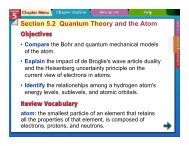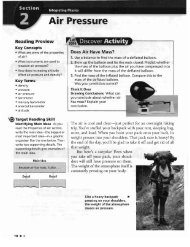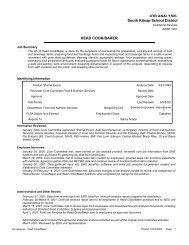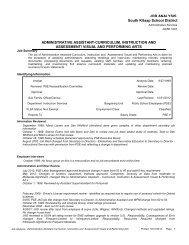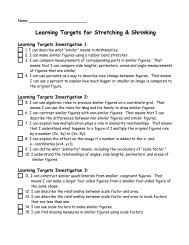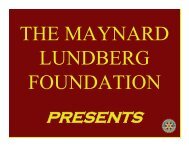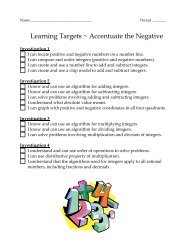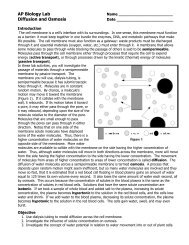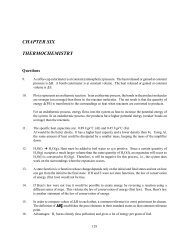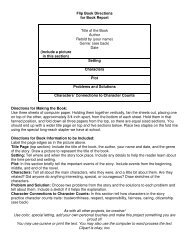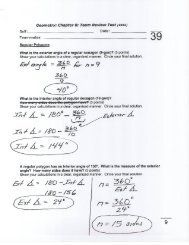Voices of Modern Culture
Voices of Modern Culture
Voices of Modern Culture
Create successful ePaper yourself
Turn your PDF publications into a flip-book with our unique Google optimized e-Paper software.
The double riser operates as follows: On minimum flow, there is initially insufficient gas velocity tocarry oil upward, and oil begins to collect in a trap at the bottom <strong>of</strong> the risers, eventually sealing thelarger line, whereupon the velocity <strong>of</strong> the smaller line increases and carries oil upward and back tothe compressor. On the resumption <strong>of</strong> full flow the seal is broken and both lines are utilized. It’simportant that the trap be made <strong>of</strong> close coupled elbows in order to provide a minimum oil holdingreservoir.Pipe Routing Important, TooBesides accurate pipe sizing to control refrigerant flow and guarantee oil return, certain physicalpiping configurations are used to aid oil return and protect the compressor from possible damagedue to liquid refrigerant “draining” into the compressor during the <strong>of</strong>f periods. Not all designersand engineers agree as to the merit <strong>of</strong> many <strong>of</strong> the loops, traps, etc., that have evolved, generallythrough experience rather that through research. For example, some designers feel that it’simportant to pitch horizontal suction lines toward the compressor to encourage oil return, others feelthat it’s unnecessary when lines are properly sized.On very high suction lift installations, where the compressor-condenser is above the cooling coil, asthe case might be when condensing sections are placed on the ro<strong>of</strong> <strong>of</strong> the multi-story apartmentbuilding, it’s <strong>of</strong>ten recommended to provide traps in the suction line at specific heights (Figure 7) toact as oil reservoirs. This is an attempt to eliminate any delay <strong>of</strong> oil return on start-up. Without thetraps, oil would drain all the way down back to the evaporator. One manufacturer’s rule is to placeone trap for every 20 to 25 ft. <strong>of</strong> elevation.5
Activity1.2 Class <strong>Culture</strong> QuiltSUGGESTED LEARNING STRATEGIES: Word Map, Graphic Organizer, CloseReading, Rereading, Brainstorming, Metacognitive Markers, Think-Pair-ShareWordConnectionsArtifact contains the roots-art- and -fac-, from theLatin words ars, whichmeans “to join or fit,”and facere, which means“to make or do.” Theseroots also appear inartisan, article, factory,manufacturing, andbenefactor.Add circles to create a word web around the word Quilting. Write wordsor phrases that you associate with quilting. Draw lines to connect thenew circles to the one shown below.QuiltingBrainstorm a list <strong>of</strong> images, artifacts, objects, memories, andexperiences from your childhood that reveal who you are as a person.Image, Artifact, Object, Memory, and/or ExperienceExplanation <strong>of</strong> Significance to You1.2.3.4.5.© 2011 College Board. All rights reserved.6.7.8. SpringBoard® English Textual Power Level 5
Activity 1.2continuedClass <strong>Culture</strong> QuiltMy Notes25303540your michigan spring faded curtain piecesmy father’s santa fe work shirtthe summer denims, the tweeds <strong>of</strong> fallin the evening you sat at your canvas—our cracked linoleum floor the drawing boardme lounging on your armand you staking out the plan:whether to put the lilac purple <strong>of</strong> easter against the redplaid <strong>of</strong> winter-goinginto-springwhether to mix a yellow with blue and white and paint thecorpus christi noon when my father held your handwhether to shape a five-point star from thesomber black silk you wore to grandmother’s funeralyou were the river currentcarrying the roaring notes . . .forming them into pictures <strong>of</strong> a little boy reclininga swallow flyingyou were the caravan master at the reinsdriving your thread needle artillery across the mosaic cloth bridgesdelivering yourself in separate testimonies455055oh mother you plunged me sobbing and laughinginto our pastinto the river crossing at fiveinto the spinach fieldsinto the plainview cotton rowsinto tuberculosis wardsinto braids and muslin dressessewn hard and taut to withstand the thrashings <strong>of</strong> twenty-five yearsstretched out they layarmed/ready/shouting/celebratingknotted with lovethe quilts sing on© 2011 College Board. All rights reserved. SpringBoard® English Textual Power Level 5
Activity 1.2continuedImagery and DictionNovelist Robert Newton Peck once said, “A good author makes a cameraout <strong>of</strong> a pen.” An author creates imagery through his or her diction.Imagery is language that appeals to the senses. Writers use it todescribe an experience and evoke a feeling.1. Review Acosta’s poem and identify two images. Explain why theimages appeal to you.2. Next, consider the topic, purpose, and occasion <strong>of</strong> Acosta’s poem.How might they shape her diction or choice <strong>of</strong> words?Literary termsImages help create picturesor ideas in the reader’smind. Most images appealto the sense <strong>of</strong> sight.Connotation is theemotional feeling attachedto a word. A connotationmay be positive, negative, orneutral.Denotation is the literalmeaning <strong>of</strong> a word.Diction is the writer’s choice<strong>of</strong> words.© 2011 College Board. All rights reserved.3. The power <strong>of</strong> a sentence or a line <strong>of</strong> poetry to produce a reaction inthe reader lies mainly in the connotations (the suggested meaning) <strong>of</strong>words. Consider the final image in the poem, “knotted with love thequilt sings on.” What are the denotations <strong>of</strong> the words knotted andsings? What are their connotations? Discuss the connotations <strong>of</strong> thewords knotted and sings.4. Consider what would happen if the author’s diction were different.For example, if instead <strong>of</strong> “knotted,” she had used “entangled,”“mixed up,” or “tied together.” How might a different word or phraseaffect the reader’s perception <strong>of</strong> the final line in the poem?WordConnectionsIn this poem, the patches<strong>of</strong> the quilt representpieces <strong>of</strong> the author’s life.The patch-quilt analogyhas also been used todescribe the make-up<strong>of</strong> the U.S. population.Explain the meaning <strong>of</strong> thisanalogy.Unit 1 • <strong>Voices</strong> <strong>of</strong> <strong>Modern</strong> <strong>Culture</strong>
Activity1.3 Contemplating <strong>Culture</strong>SUGGESTED LEARNING STRATEGIES: Word Map, Graphic Organizer,Discussion Groups, Think-Pair-Share, VisualizingAdd circles to create a word web around the word <strong>Culture</strong>. Write wordsor phrases that you associate with culture. Draw lines to connect thenew circles to the one shown below.<strong>Culture</strong>Use your prior knowledge and what you have learned in the unit to writea definition <strong>of</strong> culture in the box below.<strong>Culture</strong> is…Discuss your definition with a small group <strong>of</strong> peers. Revise yourdefinition to include any new ideas you have about culture.<strong>Culture</strong> Word SortYour teacher will provide you with a set <strong>of</strong> index cards. Each cardcontains a word that describes some element <strong>of</strong> culture. You willwork in groups to sort the words into stacks <strong>of</strong> words that arerelated. After placing all the words in stacks, your group will choosea category to describe each <strong>of</strong> your stacks.<strong>Culture</strong> VocabularyYou will next work in groups to describe the meaning <strong>of</strong> one <strong>of</strong> thefollowing words relating to culture. Your teacher will assign eachgroup a word. On separate paper, work with your group to defineyour term. Draw an illustration that represents the key ideas in yourword.customs diversity ethnocentrismassimilation stereotypes cultural norms© 2011 College Board. All rights reserved.10 SpringBoard® English Textual Power Level 5
Aspects <strong>of</strong> <strong>Culture</strong>: IntroducingOutside ReadingActivity1.4SUGGESTED LEARNING STRATEGIES: Marking the Text, Notetaking, Think-Pair-ShareM e m o i rMy Notes© 2011 College Board. All rights reserved.A b o u t t h e A u t h o rBorn in Abadan, Iran, writer Firoozeh Dumas spent much<strong>of</strong> her childhood living in California. She credits her father,a Fulbright scholar and engineer who attended Texas A&MUniversity, and his fondness for humorous storytelling, forinspiring her to write stories <strong>of</strong> her own. After the events<strong>of</strong> September 11, 2001, friends urged Dumas to publishher stories as a way to remind readers <strong>of</strong> the humor andhumanity <strong>of</strong> Middle Eastern cultures.fromby Firoozeh DumasWhen I was seven, my parents, my fourteen-year-old brother, Farshid,and I moved from Abadan, Iran, to Whittier, California. Farid, the older <strong>of</strong>my two brothers, had been sent to Philadelphia the year before to attendhigh school. Like most Iranian youths, he had always dreamed <strong>of</strong> attendingcollege abroad and, despite my mother’s tears, had left us to live with myuncle and his American wife. I, too, had been sad at Farid’s departure, but mysorrow soon faded—not coincidentally, with the receipt <strong>of</strong> a package fromhim. Suddenly, having my brother on a different continent seemed like asmall price to pay for owning a Barbie complete with a carrying case and fouroutfits, including the rain gear and mini umbrella.Our move to Whittier was temporary. My father, Kazem, an engineerwith the National Iranian Oil Company, had been assigned to consult for anAmerican firm for about two years. Having spent several years in Texas andCalifornia as a graduate student, my father <strong>of</strong>ten spoke about America withthe eloquence and wonder normally reserved for a first love. To him, Americawas a place where anyone, no matter how humble his background, couldbecome an important person. It was a kind and orderly nation full <strong>of</strong> cleanbathrooms, a land where traffic laws were obeyed and where whales jumpedthrough hoops. It was the Promised Land. For me, it was where I could buymore outfits for Barbie.We arrived in Whittier shortly after the start <strong>of</strong> second grade; my fatherenrolled me in Leffingwell Elementary School. To facilitate my adjustment,the principal arranged for us to meet my new teacher, Mrs. Sandberg, a fewdays before I started school. Since my mother and I did not speak English,Literary termsVoice is the way a writeror speaker uses words andtone to express ideas aswell as his or her personasor personalities.Grammar&UsageIf you examine the writer’ssyntax, you will noticeher use <strong>of</strong> subordinatestructures, such assubordinate clauses andappositives. The openingsentence, for example,contains an introductoryadverbial clause and anappositive, in which sheincludes details related tothe point <strong>of</strong> the sentence.The opening complexsentence is also a periodicsentence, one in whichthe main clause comeslast, requiring the readerto complete the wholesentence to get themeaning.Consider the effect <strong>of</strong> thewriter’s syntactical choiceson the flow, rhythm, andcontent <strong>of</strong> this essay.Unit 1 • <strong>Voices</strong> <strong>of</strong> <strong>Modern</strong> <strong>Culture</strong> 11
Activity 1.4continuedAspects <strong>of</strong> <strong>Culture</strong>: IntroducingOutside ReadingWordConnectionsEloquence contains theroot -loqu-, from the Latinword loqui, meaning “tospeak.” This root alsoappears in loquacious andcolloquial. The suffix -enceindicates that the word isa noun.My Notesthe meeting consisted <strong>of</strong> a dialogue between my father and Mrs. Sandberg.My father carefully explained that I had attended a prestigious kindergartenwhere all the children were taught English. Eager to impress Mrs. Sandherg,he asked me to demonstrate my knowledge <strong>of</strong> the English language. I stoodup straight and proudly recited all that I knew: “White, yellow, orange, red,purple, blue, green.”The following Monday, my father drove my mother and me to school.He had decided that it would be a good idea for my mother to attend schoolwith me for a few weeks. I could not understand why two people not speakingEnglish would be better than one, but I was seven, and my opinion didn’tmatter much.Until my first day at Leffingwell Elementary School, I had never thought<strong>of</strong> my mother as an embarrassment, but the sight <strong>of</strong> all the kids in the schoolstaring at us before the bell rang was enough to make me pretend I didn’tknow her. The bell finally rang and Mrs. Sandberg came and escorted usto class. Fortunately, she had figured out that we were precisely the kind <strong>of</strong>people who would need help finding the right classroom.My mother and I sat in the back while all the children took their assignedseats. Everyone continued to stare at us. Mrs. Sandberg wrote my name onthe board: F-l-R-O-O-Z-E-H. Under my name, she wrote “I-R-A-N.” She thenpulled down a map <strong>of</strong> the world and said something to my mom. My momlooked at me and asked me what she had said. I told her that the teachersprobably wanted her to find Iran on the map.The problem was that my mother, like most women <strong>of</strong> her generation,had been only briefly educated. In her era, a girl’s sole purpose in life wasto find a husband. Having an education ranked far below more desirableattributes such as the ability to serve tea or prepare baklava. Before hermarriage, my mother, Nazireh, had dreamed <strong>of</strong> becoming a midwife. Herfather, a fairly progressive man, had even refused the two earlier suitors whohad come for her so that his daughter could pursue her dream. My motherplanned to obtain her diploma, then go to Tabriz to learn midwifery from ateacher whom my grandfather knew. Sadly, the teacher died unexpectedly,and my mother’s dreams had to be buried as well.Bachelor No. 3 was my father. Like the other suitors, he had never spokento my mother, but one <strong>of</strong> his cousins knew someone who knew my mother’ssister, so that was enough. More important, my mother fit my father’sphysical requirements for a wife. Like most Iranians, my father preferred afair-skinned woman with straight, light-colored hair. Having spent a year inAmerica as a Fulbright scholar, he had returned with a photo <strong>of</strong> a womanhe found attractive and asked his older sister, Sedigeh, to find someone whoresembled her. Sedigeh had asked around, and that is how at age seventeenmy mother <strong>of</strong>ficially gave up her dreams, married my father, and had a childby the end <strong>of</strong> the year.© 2011 College Board. All rights reserved.12 SpringBoard® English Textual Power Level 5
Activity 1.4continued© 2011 College Board. All rights reserved.As the students continued staring at us, Mrs. Sandberg gestured to mymother to come up to the board. My mother reluctantly obeyed. I cringed.Mrs. Sandberg, using a combination <strong>of</strong> hand gestures, started pointing tothe map and saying, “Iran? Iran? Iran?” Clearly, Mrs. Sandberg had plannedon incorporating us into the day’s lesson. I only wished she had told us thatearlier so we could have stayed home.After a few awkward attempts by my mother to find Iran on the map,Mrs. Sandberg finally understood that it wasn’t my mother’s lack <strong>of</strong> Englishthat was causing a problem, but rather her lack <strong>of</strong> world geography. Smilinggraciously, she pointed my mother back to her seat. Mrs. Sandberg thenshowed everyone, including my mother and me, where Iran was on the map.My mother nodded her head, acting as if she had known the location all alongbut had preferred to keep it a secret. Now all the students stared at us, notjust because I had come to school with my mother, not because we couldn’tspeak their language, but because we were stupid. I was especially mad atmy mother, because she had negated the positive impression I had madepreviously by reciting the color wheel. I decided that starting the next day, shewould have to stay home.The bell finally rang and it was time for us to leave. LeffingwellElementary was just a few blocks from our house and my father, grosslyunderestimating our ability to get lost, had assumed that my mother andI would be able to find our way home. She and I wandered aimlessly,perhaps hoping for a shooting star or a talking animal to help guide us back.None <strong>of</strong> the streets or houses looked familiar. As we stood pondering ourpredicament, an enthusiastic young girl came leaping out <strong>of</strong> her house andsaid something. Unable to understand her, we did what we had done all day:we smiled. The girl’s mother joined us, then gestured for us to follow herinside. I assumed that the girl, who appeared to be the same age as I, was astudent at Leffingwell Elementary; having us inside her house was probablyakin to having the circus make a personal visit.Her mother handed us a telephone, and my mother, who had, thankfully,memorized my father’s work number, called him and explained our situation.My father then spoke to the American woman and gave her our address. Thiskind stranger agreed to take us back to our house.Perhaps fearing that we might show up at their doorstep again, thewoman and her daughter walked us all the way to our front porch and evenhelped my mother unlock the unfamiliar door. After making one last futileattempt at communication, they waved good-bye. Unable to thank them inwords, we smiled even more broadly.After spending an entire day in America, surrounded by Americans,I realized that my father’s description <strong>of</strong> America had been correct. Thebathrooms were clean and the people were very, very kind.My NotesUnit 1 • <strong>Voices</strong> <strong>of</strong> <strong>Modern</strong> <strong>Culture</strong> 13
Activity1.5Components <strong>of</strong> EffectiveCommunicationSUGGESTED LEARNING STRATEGIES: Quickwrite, Graphic Organizer, NotetakingTake notes as the class brainstorms the meaning <strong>of</strong> communication.Read the text below. Then fill in the graphic organizer.Facts About ConversationsEvery conversation must have both a sender and a receiver <strong>of</strong>information. When the sender sends the information to the receiver,the receiver must first filter that information through his or her pastexperiences or frame <strong>of</strong> reference. For example, when you are asked todraw a dog, you probably think about dogs you have seen. The sameprocess occurs in discussions <strong>of</strong> more complex ideas and issues. Themessage from the sender must be translated by the receiver in order tobe understood.Label each shape in the graphic organizer with terms introduced in theparagraph above.Discussion: Observe your classmates as they attempt to communicatea simple or complex task. Use these questions to discuss the process <strong>of</strong>communication.1. Was there ever a point at which communication broke down becausethe two individiuals did not identify things in the same way?2. What variables appear to affect one-on-one communication?© 2011 College Board. All rights reserved.3. Explain how the sender was conscious <strong>of</strong> the need to be clear and toconnect with the receiver’s past experiences.4. What strategies might be used to minimize barriers and improvecommunication?14 SpringBoard® English Textual Power Level 5
Activity 1.5continuedCreating Group NormsThe quotations that follow reflect how people act when theycommunicate with each other. Read the quotations and make inferencesabout how to best communicate with others.“The problem with communication . . . is the illusion that it has beenaccomplished.” George Bernard Shaw“The newest computer can merely compound, at speed, the oldestproblem in the relations between human beings, and in the end thecommunicator will be confronted with the old problem, <strong>of</strong> what to sayand how to say it.” Edward R. Murrow“The greatest compliment that was ever paid me was when someoneasked me what I thought, and attended to my answer.” Henry DavidThoreauGrammar&UsageNotice the reciprocalpronoun <strong>of</strong> each other inthe second line. Reciprocalpronouns show a two-wayaction, as in two peoplecommunicating. Each otheris used to describe actionsbetween two people. Oneanother is also a reciprocalpronoun and is used todescribe actions betweenmore than two people, asin students in the classcommunicating with oneanother.“Most conversations are simply monologues delivered in the presence<strong>of</strong> a witness.” Margaret Miller“I like to listen. I have learned a great deal from listening carefully. Mostpeople never listen.” Ernest Hemingway“I remind myself every morning: Nothing I say this day will teach meanything. So if I’m going to learn, I must do it by listening.” Larry King© 2011 College Board. All rights reserved.“If speaking is silver, then listening is gold.” Turkish ProverbIdentify two to three norms (guidelines) you and your fellow students canfollow to communicate effectively when you work with partners or in groups.1.2.3.Unit 1 • <strong>Voices</strong> <strong>of</strong> <strong>Modern</strong> <strong>Culture</strong> 15
Activity1.6What Contributes to Our Perceptions<strong>of</strong> the World?SUGGESTED LEARNING STRATEGIES: Brainstorming, Quickwrite,Graphic Organizer, Think-Pair-ShareAfter looking at the images your teacher provides, record in theorganizer below the meanings and associations evoked by the images.Image My First Associations Responses from PeersQuickwrite: Respond to the Essential Question, “How can culturalexperiences shape, impact, or influence our perception <strong>of</strong> the world?”Academic VocaBularyA symbol is a thing thatrepresents or standsfor something else. Forexample, a flag is a symbol<strong>of</strong> a country; a dove is asymbol <strong>of</strong> peace.Brainstorm at least five artifacts that serve as symbols for you, your life,and your culture that you could include in a “Perception Box” <strong>of</strong> yourown. What do the objects reveal about you and your culture?© 2011 College Board. All rights reserved.16 SpringBoard® English Textual Power Level 5
Activity<strong>Culture</strong> and Art 1.7SUGGESTED LEARNING STRATEGIES: Close Reading, Graphic Organizer,Questioning the Text, Discussion GroupsUse the image or artwork provided by your teacher to complete thegraphic organizer below.Title <strong>of</strong> Artwork:Author:SeeWhat details do youobserve in the artwork?I see . . .I notice . . .MeanWhat might thesedetails mean? (Hint:Consider connotativeassociations that maybe symbolic.)Consider color, shapes,and objects you see.© 2011 College Board. All rights reserved.MatterTo whom does theimage matter, and why?What conclusions canyou draw about thecreator <strong>of</strong> the image?What can you say aboutthe purpose or effect <strong>of</strong>the image?Interpretive or Thematic Statement:Unit 1 • <strong>Voices</strong> <strong>of</strong> <strong>Modern</strong> <strong>Culture</strong> 17
Activity1.8<strong>Culture</strong> and LiteratureSUGGESTED LEARNING STRATEGIES: Close Reading, Marking the Text,TWIST, Previewing, Predicting, Rereading, DraftingMy NotesP o e t r yWhile reading, examine howthe text features <strong>of</strong> this poem(for example, indentation,stanzas, italics, and singlelines) advance the author’stheme and voice.A b o u t t h e A u t h o rLangston Hughes (1902–1967) is one <strong>of</strong> the great AfricanAmerican poets <strong>of</strong> the twentieth century. While workingas a busboy in a Washington, D.C., hotel, Hughes <strong>of</strong>feredhis writing to poet Vachel Lindsay, who was so impressedthat he helped launch Hughes’s career. Over the nextfifty years, Hughes wrote poetry, plays, and translations,and edited anthologies that voiced the concerns andexperiences <strong>of</strong> black Americans.by Langston Hughes51015The instructor said,Go home and writea page tonight.And let that page come out <strong>of</strong> you —Then, it will be true.I wonder if it’s that simple?I am twenty-two, colored, born in Winston-Salem.I went to school there, then Durham, then hereto this college on the hill above Harlem.I am the only colored student in my class.The steps from the hill lead down to Harlem,through a park, then I cross St. Nicholas,Eighth Avenue, Seventh, and I come to the Y,the Harlem Branch Y, where I take the elevatorup to my room, sit down, and write this page:© 2011 College Board. All rights reserved.18 SpringBoard® English Textual Power Level 5
Activity 1.8continuedIt’s not easy to know what is true for you or meat twenty-two, my age. But I guess I’m whatI feel and see and hear. Harlem, I hear you:hear you, hear me — we two — you, me talk on this page.My Notes(I hear New York, too.) Me — who?20Well, I like to eat, sleep, drink, and be in love.I like to work, read, learn, and understand life.I like a pipe for a Christmas present,or records — Bessie, bop, or Bach.© 2011 College Board. All rights reserved.I guess being colored doesn’t make me not likethe same things other folks like who are other races.So will my page be colored that I write?Being me, it will not be white.But it will bea part <strong>of</strong> you, instructor.You are white —yet a part <strong>of</strong> me, as I am a part <strong>of</strong> you.That’s American.Sometimes perhaps you don’t want to be a part <strong>of</strong> me.Nor do I <strong>of</strong>ten want to be a part <strong>of</strong> you.Be we are, that’s true!As I learn from you,I guess you learn from me —although you’re older — and white —and somewhat more free.25303540This is my page for English B.Unit 1 • <strong>Voices</strong> <strong>of</strong> <strong>Modern</strong> <strong>Culture</strong> 19
Activity 1.8continued<strong>Culture</strong> and LiteratureTWIST Response Textual SupportTone: the attitude <strong>of</strong> the speakertoward the subjectWord Choice: the specificwords and their connotations,associations, or emotional impactImagery: the sense impressions(sound, smell, sight, taste, andtouch)Style: the author’s use <strong>of</strong>language, including figurativelanguage and poetic devices suchas repetition, rhyme, and rhythmTheme: the author’s insightabout life© 2011 College Board. All rights reserved.Thesis Statement:20 SpringBoard® English Textual Power Level 5
ActivityCircles <strong>of</strong> Influence 1.9SUGGESTED Learning Strategies: Graphic Organizer, Close Reading,Marking the Text, Rereading, Drafting, Revisit Prior Work, Think-Pair-ShareThe graphic organizer below identifies several subcultures in thiscountry. Think about your experiences as members <strong>of</strong> each subculture.Then identify images or ideas that reflect each. Write those words orimages in the appropriate circle.Academic VocaBularyA subculture is a smallersubsection <strong>of</strong> a culture; forexample, the artsy studentsare a subculture within theculture <strong>of</strong> a high school.CountryStateCitySchoolNeighborhood© 2011 College Board. All rights reserved.Familyunit 1 • <strong>Voices</strong> <strong>of</strong> <strong>Modern</strong> <strong>Culture</strong> 21
Activity 1.9continuedCircles <strong>of</strong> InfluenceMy NotesP o e t r yA b o u t t h e A u t h o rGeorge Ella Lyon is the author <strong>of</strong> award-winning children’sbooks, including Catalpa, a book <strong>of</strong> poetry that won theAppalachian Book <strong>of</strong> the Year Award, and the novel Witha Hammer for My Heart. Lyon is <strong>of</strong>ten asked about herunusual first name. On her Website, she explains that shewas named after her uncle George and her aunt Ella.&Grammar UsageNotice the writer’s use <strong>of</strong>anaphora — the repetition<strong>of</strong> a word or phrase at thebeginning <strong>of</strong> a line. Lyonrepeats “I am from” (or“I’m from”) in each stanza.This repetition creates apattern that emphasizesher thematic idea —herorigins and history. Eachuse <strong>of</strong> the phrase “I amfrom” reveals somethingabout the speaker’sidentity.510by George Ella LyonI am from clothes-pinsfrom Clorox and carbon-tetrachloride. 1I am from the dirt under the back porch.(Black, glistening,it tasted like beets.)I am from the forsythia bush,the Dutch Elmwhose long gone limbs I rememberas if they were my own.I’m from fudge and eyeglasses,© 2011 College Board. All rights reserved.from Imogene and Alafair.1carbon tetrachloride, n., chemical used for dry cleaning22 SpringBoard® English Textual Power Level 5
Activity 1.9continuedI’m from the know-it-allsand the pass-it-ons,from Perk up! and Pipe down!I’m from He restoreth my soulwith a cottonball lamband ten verses I can say myself.15My NotesI’m from Artemus and Billie’s Branch,fried corn and strong c<strong>of</strong>fee.From the finger my grandfather lostto the auger, 2the eye my father shut to keep his sight.20© 2011 College Board. All rights reserved.Under my bed was a dress boxspilling old pictures,a sift <strong>of</strong> lost facesto drift beneath my dreams.I am from those moments—snapped before I budded—leaf-fall from the family tree.Writing Prompt: Write your own “Where I’m From” poem emulatingthe style <strong>of</strong> George Ella Lyon. Consider using anaphora to createrhythm and an effective pattern to convey aspects <strong>of</strong> your culture.252auger, n., a hand too used to dig holes in wood or dirtunit 1 • <strong>Voices</strong> <strong>of</strong> <strong>Modern</strong> <strong>Culture</strong> 23
EmbeddedAssessment 1Creating an ArtisticRepresentation <strong>of</strong> My <strong>Culture</strong>SUGGESTED Learning Strategies: Graphic Organizer,Drafting, Self-EditingAssignmentYour assignment is to create a three-dimensional artistic representation <strong>of</strong>your culture and compose a written text that explains the significance <strong>of</strong> two<strong>of</strong> the symbols you have chosen to represent yourself.StepsPlanning1. Use the graphic organizer on the next page (or one that you create) togenerate a list <strong>of</strong> symbols that represent the cultures with which youidentify. You may also draw on the “Where I’m From” poem you wrote forActivity 1.9.2. Select two symbols from each category (a total <strong>of</strong> ten) and think <strong>of</strong> anartistic method for making each symbol. You may use painting, sculpture,collage, found materials, watercolors, cut paper, ink, pastels, and/oractual artifacts or souvenirs, and so on. Remember that your final productmust be three-dimensional, not a flat surface.Creating3. Collect and/or create the objects for your artistic representation.4. Then choose two symbols from the ten you created that are especiallymeaningful to you. Write one or two paragraphs that explain thesignificance <strong>of</strong> the two symbols.Refining5. Experiment with various arrangements until you find a way to display theten objects that is aesthetically pleasing and engages your audience.6. As you look at your artistic representation, try to anticipate questionsthat your audience might have. Practice answering the questions aloud.7. When you revise your written explanation <strong>of</strong> the significance <strong>of</strong> yoursymbols, try to incorporate answers to those anticipated questionsinto your explanation. Include in your draft an explanation <strong>of</strong> how youorganized your artistic representation and why you chose to map it in thatorder.8. Edit your written explanation using the tools available to you to present atechnically sound document.9. Be prepared to share and explain your artistic representation <strong>of</strong> yourculture to a small group or in a gallery walk setting.10. End-<strong>of</strong>-Task Reflection: Did people read my symbols in the way that Ithought they would? Explain. How might I map, or organize, my artisticrepresentation differently to better communicate my ideas?© 2011 College Board. All rights reserved.24 SpringBoard® English Textual Power Level 5
EmbeddedAssessment 1continuedReview the detailed lists that you made for the Circles <strong>of</strong> Influence activity(Activity 1.9). Consider those details as well as new ones that come to mindas you list objects or artifacts that represent your culture or cultures. List asmany details or items as you can in each box. You may want to add additionalcategories.Family Sports or Hobbies Clothing EducationFood Music or Art Religion Gender Roles© 2011 College Board. All rights reserved.Highlight the five categories on the organizer that most strongly identify anddefine you culturally. Choose two items from each category to include in yourproject. (Remember, you have to represent them artistically.)Then choose two items that you feel represent you in a significant way andexplain how they symbolize you culturally.Unit 1 • <strong>Voices</strong> <strong>of</strong> <strong>Modern</strong> <strong>Culture</strong> 25
EmbeddedAssessment 1continuedCreating an ArtisticRepresentation <strong>of</strong> My <strong>Culture</strong>Scoring GuideScoringCriteriaExemplary Pr<strong>of</strong>icient EmergingArtisticRepresentationThe three-dimensional artform can be characterizedas unique, thoughtprovoking, and visuallyengaging.The representationdemonstrates an extensiveeffort to include anassortment <strong>of</strong> symbolsfrom a variety <strong>of</strong> categoriesand to organize them ina way that enables theaudience to make sense <strong>of</strong>the piece as a whole.The three-dimensional artform can be characterizedas interesting and visuallypleasing.The representationdemonstrates an effortto include symbols fromdifferent categories that areorganized in a logical way.The three-dimensionalart form is attempted, yetit may be characterizedas confusing or visuallydistracting.The representationdemonstrates little effortto include symbols fromdifferent categories,and the symbols may bedisorganized.ExplanatoryTextThe explanatory text clearlyand thoroughly explainsthe meaning <strong>of</strong> twosymbols from the artisticrepresentation, includingtheir relationship to theartist’s culture(s), as wellas the significance <strong>of</strong> theartistic method chosen toportray each symbol.The explanationdemonstrates the author’skeen ability to anticipateviewers’ questions.The explanatory textdiscusses the meaning<strong>of</strong> two symbols from theartistic representation,including the relationshipto the artist’s culture(s), aswell as the significance <strong>of</strong>the artistic method chosento portray each symbol.The explanationdemonstrates the author’sbasic ability to anticipateviewers’s questions.The explanatory textattempts to discussthe meaning <strong>of</strong> twosymbols from the artisticrepresentation but maynot adequately showthe relationship to theartist’s culture(s) or thesignificance <strong>of</strong> the artisticmethod chosen to portrayeach symbol.The explanation does notdemonstrate the author’sability to anticipateviewers’ questions.© 2011 College Board. All rights reserved.26 SpringBoard® English Textual Power Level 5
EmbeddedAssessment 1continuedScoring GuideScoringCriteriaExemplary Pr<strong>of</strong>icient EmergingEvidence <strong>of</strong>the WritingProcessThere is extensive evidencethat the explanatory textreflects the various stages<strong>of</strong> the writing process.There is evidence that theexplanatory text reflectsstages <strong>of</strong> the writingprocess.There is little or noevidence that theexplanatory text hasundergone stages <strong>of</strong> thewriting process.ReflectionThe reflection shows athorough metacognitiveanalysis describing viewers’and readers’ reactions tothe artist’s representationand how revisions could bemade accordingly.The reflection adequatelyshows a metacognitiveanalysis explaining anddescribing viewers’ andreaders’ reactions and howrevisions could be madeaccordingly.The reflection attempts toshow some metacognitiveanalysis describingviewers’ and readers’reactions but not thorouglyenough to explain howrevisions could be madeaccordingly.AdditionalCriteriaComments:© 2011 College Board. All rights reserved.Unit 1 • <strong>Voices</strong> <strong>of</strong> <strong>Modern</strong> <strong>Culture</strong> 27
Learning Focus:You Have Great VoiceAfter watching the latest person audition on a television show, your friendturns to you and says, “That dude’s got a great voice.” The meaning <strong>of</strong> voicein this context seems pretty clear; but what would it mean if, after readinga new story in class, your friend turned to you and said, “Wow, I love thewriter’s voice in this poem”? Or what if your teacher asked you, “How doesyour voice change in different social situations”? These last two questionsare central to the idea that “voice” is a deliberate creation, an expression <strong>of</strong>who you are.It is clear that there are many different factors that shape who you are. Yourfamily, the social roles you play, and the groups or subcultures you belongto all represent different areas or contexts that influence how you think andact and speak. They affect how you talk and what you talk about—in short,your voice. You probably talk and act differently in different contexts or roles.These differences help explain the concept <strong>of</strong> voice.Modifying your voice—what you talk about, the words you use to expressyourself, and the manner in which you deliver your words—is something youdo every day in speaking about different subjects to different audiences. Youtrade information with your friends differently than you persuade the adultsin your life to do what you want.In writing, as in speaking, voice is conveyed by the choices you make insubject matter, in diction, syntax, and punctuation. Crafting your writingdeliberately to communicate a certain voice illustrates the power written andspoken language has to entertain, persuade, complain, censure, praise, andamuse. Your ability to manipulate language to convey voice is central to yoursuccess as a writer, as a communicator, and as an individual.© 2011 College Board. All rights reserved.28 SpringBoard® English Textual Power Level 5
ActivityWhat Gives Writing a Voice? 1.10SUGGESTED Learning StrATEGIES: Marking the Text, Think-Pair-Share, Word Map© 2011 College Board. All rights reserved.Voice and WritingExcerpted from Pacesetter English:<strong>Voices</strong> <strong>of</strong> <strong>Modern</strong> <strong>Culture</strong>What gives writing a “voice”? The metaphor on which the term is builtincorporates two things associated with the human voice—the articulation<strong>of</strong> personality, individuality, and the speaking out, the emerging from silenceinto speech.“Voice” in writing seems to imply distinctive qualities, uniqueness,that which makes writing personal—not mainly in terms <strong>of</strong> content (thoughWHAT is said is believed to bring about writing with a “strong voice”) . . . butin terms <strong>of</strong> style. Writing “with a strong voice” characterizes the writer, bothconfirming and projecting his or her identity.“Voice” also implies a speaking out, a refusal to be without language.Often, this quality is associated with the social voices <strong>of</strong> writers who arein some sense oppressed or who are denied the opportunity to speak theireperiences by a dominating “mainstream,” but a writer’s connection to asocial group can take other forms as well. This social aspect <strong>of</strong> “voice” ismore than psychological; it presents itself within a cultural context, claimsa space within a conversation. To do this, such writing needs to representnot just an individual but also a kind <strong>of</strong> experience that has resonance forsome people besides the writer, members <strong>of</strong> some group whose identity ASA GROUP matters. That group could be any group: a recognized ethnic orracial population or a subgroup <strong>of</strong> the high school student population, such asfemale athletes, musicians, working students, etc.These two shades <strong>of</strong> meaning in the word voice seem to be on a collisioncourse: one looks for the qualities <strong>of</strong> an individual style, the other at how apiece <strong>of</strong> writing articulates a cultural perspective shared by more than oneperson. Our criteria need to account for writing that does both, that is bothdistinctive and culturally powerful.Essential QuestionHow does voice function in and beyond the contexts <strong>of</strong> writing?Literary termSStyle is the distinctive waya writer uses language. It ischaracterized by elementssuch as diction, syntax,imagery, and use <strong>of</strong> literarydevices.WordConnectionsPsychological containstwo roots, -psych- and-logy-, from the Greekwords psyche, meaning“soul or breath” and logos,meaning “word.” The rootsalso appear in psychic,psychotic, biology, andlogical. The suffix -alindicates that the word isan adjective.Academic VocaBularyA perspective is one’sattitude or way <strong>of</strong> looking atthe world.unit 1 • <strong>Voices</strong> <strong>of</strong> <strong>Modern</strong> <strong>Culture</strong> 29
Activity 1.10continuedWhat Gives Writing a Voice?Use these questions to guideyour reading <strong>of</strong> the poem.P o e t r y• What are the voices <strong>of</strong> thespeaker? Highlight linesthat indicate the speaker’sidentities.• How does diction showidentity? Highlight examples.• Who is the audience?• What is the author’spurpose?A b o u t t h e A u t h o rPat Mora is a poet, writer, and social activist whoseworks explore issues <strong>of</strong> heritage and social inequality.An avid traveler, Mora wrote Communion (1991) abouther experiences traveling in Cuba, India, and Pakistan.A year later, she published her first children’s book abouta beloved aunt who taught her to appreciate her ownMexican-American heritage.• What is the speaker’sattitude or tone? Markthe text to show textualevidence.&Grammar UsageEvery writer has a uniquevoice. It is achieved inpart through word choiceand syntax. Poet Pat Morademonstrates a distinctvoice in “Legal Alien”by mixing English andSpanish and repeating thephrase able to . . . in lines2, 4, and 6. She sets upa parallel series with theverb able followed by aninfinitive:able to slip …, able tosit …, able to order …Ask yourself how yourown choices <strong>of</strong> words andphrases help express yourunique voice.5101520by Pat MoraBi-lingual, Bi-cultural,able to slip from “How’s life?”to “Me’stan volviendo loca,”able to sit in a paneled <strong>of</strong>ficedrafting memos in smooth English,able to order in fluent Spanishat a Mexican restaurant,American but hyphenated,viewed by Anglos as perhaps exotic,perhaps inferior, definitely different,viewed by Mexicans as alien,(their eyes say, “You may speakSpanish but you’re not like me”)an American to Mexicansa Mexican to Americansa handy tokensliding back and forthbetween the fringes <strong>of</strong> both worldsby smilingby masking the discomfort<strong>of</strong> being pre-judgedBi-laterally.© 2011 College Board. All rights reserved.30 SpringBoard® English Textual Power Level 5
Analyzing Components <strong>of</strong> VoiceActivity1.11SUGGESTED Learning Strategies: Graphic Organizer,Notetaking, Drafting, Think-Pair-ShareAs you watch the short clip from the film Grease, note how JohnTravolta’s character, Danny, changes in the scene. Record the verbaland nonverbal details that characterize his two voices.T-Bird DannySandy’s DannyIn what ways does Danny’s voice change in the scene? Why?1. Write an e-mail to the principal explaining why you were lateto school.© 2011 College Board. All rights reserved.2. Write an e-mail to your best friend explaining why you were lateto school.3. What differences do you notice in your voice? Explain.4. How did your diction express a unique voice, and how did it change inyour e-mail from one audience to the other?Unit 1 • <strong>Voices</strong> <strong>of</strong> <strong>Modern</strong> <strong>Culture</strong> 31
Activity1.12 Voice and StyleSUGGESTED Learning Strategies: Quickwrite, Graphic Organizer,Think-Pair-Share, VisualizingMad Talk QuickwriteReflection on Syntax, Diction,and ToneS<strong>of</strong>t Talk QuickwriteReflection on Syntax, Diction,and ToneFast Talk QuickwriteReflection on Syntax, Diction,and ToneLiterary termsTone is a writer’s attitudetoward his or her subject oraudience.Syntax is the way in whichwords are put together tomake meaningful elements,such as phrases, clauses,and sentences.Diction is the writer’s choice<strong>of</strong> words.Now choose one <strong>of</strong> these voices to present orally to your classmates.Use facial expressions, eye contact, and tone to convey emotion.What differences do you notice among the voices in otherpresentations?What factors explain the differences between the voices?© 2011 College Board. All rights reserved.32 SpringBoard® English Textual Power Level 5
Experimenting with ToneActivity1.13SUGGESTED Learning Strategies: Close Reading, Marking the Text,Revisiting Prior Work, Brainstorming, Think-Pair-ShareSelect a tone word and use a thesaurus to create an array <strong>of</strong> relatedwords.Tone arrayMy NotesS o n g L y r i c sA b o u t t h e A u t h o rJohn Lennon (1940–1980) is best known as one <strong>of</strong> the foundingmembers <strong>of</strong> the pop group the Beatles. Lennon’s song“Imagine,” reflects the singer’s beliefs in the power <strong>of</strong> peacefulaction. Lennon was assassinated on December 8, 1980.© 2011 College Board. All rights reserved.by John LennonImagine there’s no heaven,It’s easy if you try,No hell below us,Above us only sky,Imagine all the peopleliving for today. . .Imagine there’s no countries,It isn’t hard to do,Nothing to kill or die for,No religion too,Imagine all the peopleLiving life in peace. . .Imagine no possessions,I wonder if you can,No need for greed or hunger,A brotherhood <strong>of</strong> man,Imagine all the peopleSharing all the world. . .You may say I’m a dreamer,but I’m not the only one,I hope some day you’ll join us,And the world will live as one.5101520Unit 1 • <strong>Voices</strong> <strong>of</strong> <strong>Modern</strong> <strong>Culture</strong> 33
Activity1.14 Contrasting <strong>Voices</strong>SUGGESTED Learning Strategies: Visualizing, Drafting, Sharing and RespondingPrewritingDraftingPersona Voice #1Persona Voice #2What changes do you notice between the two voices? What explainsthese differences?© 2011 College Board. All rights reserved.34 SpringBoard® English Textual Power Level 5
ActivityPunctuating Personality 1.15SUGGESTED Learning Strategies: Quickwrite, Graphic Organizer,SOAPSTone, Close Reading, Marking the Text, Think-Pair-Share, AddingUsing a grammar handbook, identify the punctuation marks below anddescribe their function.Mark Name Purpose/Function*!.?,;:--© 2011 College Board. All rights reserved.( )[ ]“ ”/Think about how you use punctuation to express yourself. Thencomplete the sentence frame below.I identify myself as a because .(punctuation mark)Unit 1 • <strong>Voices</strong> <strong>of</strong> <strong>Modern</strong> <strong>Culture</strong> 35
Activity 1.15continuedPunctuating PersonalityWordConnectionsMonologue contains theroot -log-, from the Greekword logos, meaning“word.” This root alsoappears in dialogue,eulogy, and epilogue. Theprefix mono- means “aloneor single.”M o n o l o g u eA b o u t t h e A u t h o rAs a playwright, author, and acting coach, DebbieLamedman has helped many teens explore their owninterests in acting. Debbie Lamedman is the editor <strong>of</strong>The Ultimate Audition Book for Teens by Teens. She hasalso performed in regional theaters around the country.Lamedman’s first play, phat girls, was published inan anthology <strong>of</strong> best plays for 2003 and it has beenperformed in numerous theaters.My Notesby Debbie LamedmanKATIE has just gotten braces put on her teeth, and she ismiserable. As her father tries to cheer her up, KATIE refuses t<strong>of</strong>eel better about the situation.KATIE: Don’t look at me…and don’t make me laugh…I look hideous.I don’t care if everyone I know has them. I care that I won’t be able to eatsolid food for the next two years. I care that every school picture will be <strong>of</strong>some FREAK.What do you mean it’ll be worth it? My teeth weren’t so bad—it’s not likeI had this huge overbite or anything. I could have lived with it. You and Momalways taught me to embrace the differences—well I would have embraced mycrooked teeth, if only you had let me.But now they’re going to be perfect and straight and I’m not sure all thissuffering is worth it, Dad…plus I’m in a lot <strong>of</strong> pain…© 2011 College Board. All rights reserved.36 SpringBoard® English Textual Power Level 5Well, I guess a chocolate milkshake would taste good right now—it won’tinvolve chewing. (Pause.)Okay, I’ll let you buy me one…but don’t think that’s going to put mein a good mood. I plan on being miserable for the next two years and I’mnot gonna smile until these things are <strong>of</strong>f and my teeth and no longer beingheld hostage.And Dad…you say one day I’ll thank you, but we’ll just see about that. Ifthat day comes…I’ll buy you a milkshake.
Activity 1.15continuedM o n o l o g u eMy Notesby Debbie LamedmanNICOLE confronts Andrew, a guy she’s admired from afar, andtells him how she feels about him.NICOLE: My friend Janet has a zoom lens on her camera so she took yourpicture when you weren’t looking. I got it blown up and it’s hanging overmy bed. I hope you don’t think that’s weird, but I think you’re…gorgeous. Imean, you look like a movie star or something. (Pause.) Oh God, I’m totallyhumiliating myself, aren’t I?I don’t know how I got the nerve to some talk to you, but I just couldn’tstand it anymore. I had to tell you how I feel.Yeah…I know I don’t even know you, but I’d like to get to know you.I guess what I’m trying to do is ask you out on a date. Maybe you think theguy is the one who is supposed to ask, but let’s face it—you didn’t even knowI existed until two minutes ago so I thought I’d better make the first move.I’m freaking you out? Why?© 2011 College Board. All rights reserved.Oh, the picture thing? Hey, I’m harmless—look I have a crush onyou—what’s the big deal? You should be flattered.I’m not a stalker!Well you don’t have to be such a jerk about it. I don’tthink I’d go out with you now even if you begged me.And you’re not as good-looking as I thought you were.(Calling after him as he walks away.) And I’mdefinitely taking your picture <strong>of</strong>f my wall. (Pause.)Men!Unit 1 • <strong>Voices</strong> <strong>of</strong> <strong>Modern</strong> <strong>Culture</strong> 37
Activity 1.15continuedPunctuating PersonalityMy NotesM o n o l o g u eby Debbie LamedmanHEATHER is interviewing for her first job as a waitress at alocal restAurant.HEATHER: Well, no…I don’t have any experience, but how hard could itpossibly be, right? You take an order—when it’s ready you bring it to them.I do that all the time at home. My family is constantly ordering me to bringthem things.Tray service? You mean carrying food out on one <strong>of</strong> those big trays?(Pause.)Yeah! I could do that. I’m really strong. I may not look it, but I did fivechin-ups for the physical fitness test at school—that’s like a record.You want to hire me? That’s great!Okay, what’s my schedule? Let’s see…well, I can’t work on Friday orSaturday nights because I just got a boyfriend and well…ya know…I gottahave a social life. I really can’t work weeknights because I’ll have homework,and my parents wouldn’t like it too much if I was working late.(Thinking.) Um…Sunday is family day sothat’s out. I’m finished with school by 2:30 but I’llneed to eat and destress from the day, so I couldprobably start my shift at 3:30 or 4 and work until6 or 6:30-7 at the absolute latest. I could workMonday, Tuesday, and Wednesday afternoons, butsometimes I have after-school activities so you’llneed to be flexible….© 2011 College Board. All rights reserved.But otherwise, I’m totally available. So…whenwould you like me to start?38 SpringBoard® English Textual Power Level 5
Activity 1.15continuedM o n o l o g u eMy Notesby Debbie LamedmanJOHNNY is interested in dating Marie. However, he is forced todeal with her brother Frank to get his permission.JOHNNY: If I knew Marie was your sister, I would have never asked her out.Nothing’s wrong with her. She’s great. That’s why I want to go out with her.But I don’t need any more enemies, so if you’d rather I didn’t date her, I won’t.Wait a minute, first you get on me for wanting to take her out, and nowyou’re on me for not wanting to? What are you trying to do, drive me crazy?Yes. I want to take out your sister. I didn’t realize I needed to ask yourpermission. But here goes…Frank, may I have the honor <strong>of</strong> taking out your sister Marie this Saturdaynight?© 2011 College Board. All rights reserved.I solemnly swear that I am not a pervert and I will be a perfect gentlemanand have her home by one. Okay…twelve. Eleven? Don’t ya think that’s kindaearly for a weekend?Okay, okay. I’ll have her home by—how’s eleven thirty—that’s a nicecompromise, right? Good. Okay. Thanks, Frank. Thanks a lot. Thanks forletting me date your sister.(Aside.) Jeez, I’m surprised he didn’t make me sign a contract.I hope he doesn’t put out a contract—on me!Unit 1 • <strong>Voices</strong> <strong>of</strong> <strong>Modern</strong> <strong>Culture</strong> 39
Activity 1.15continuedPunctuating PersonalityMy NotesM o n o l o g u eby Debbie LamedmanWordConnectionsUnderstanding boththe denotation andconnotation <strong>of</strong> wordscan help you use andunderstand analogies. Forexample, colors are <strong>of</strong>tenused to describe emotion.Think about using “blue”to describe someonewho is sad. Complete thefollowing analogy.red : angry ::yellow :a. deathb. happyc. flowerd. funnyCHRIS explains to his father that he is not interested in playingon the basketball team his father is coaching and he wouldmuch rather be a musician.CHRIS: Look Dad, I don’t know how to tell you this…so I’m just gonna sayit—I think it’s great that you’re coaching the basketball team. I think you’ll bea great coach, but…I don’t want to be on the team.No! It has nothing to do with you! See—that’s what I’m talking about.YOU want me to be on the team. YOU want me to be a great basketballplayer, but you never asked me what I want. I don’t even like basketball. I’mnot good at it and I probably never will be. You’ve never asked me what I’mgood at. Just because you’re good at sports doesn’t mean I am. And what Ireally want to do is study music. That’s what I’m good at, Dad, and that’s whatI want to do.I want to play piano—classical or jazz—any kind <strong>of</strong> music, really. Ijust want to get really, really good at it. I want to be the best piano playerthere ever was and I want to compose my own stuff and play concerts andeverything…C’mon Dad—don’t be mad. You wouldn’t be proud <strong>of</strong> a son who waslousy on the court, but think how proud you’ll be when you see me playing atCarnegie Hall.© 2011 College Board. All rights reserved.40 SpringBoard® English Textual Power Level 5
Activity 1.15continuedM o n o l o g u eMy Notesby Debbie LamedmanGREG is having dinner at his girlfriend Cindy’s house. Cindyhas prepared a meal that is absolutely awful. GREG tries to beas polite and tactful as possible regarding Cindy’s cookingbecause he wantS to continue dating her.GREG: So…Cindy…this is really good. Seriously, I had no idea you were sucha great cook. You could probably become a famous chef or something—that’show good you are.I never really ate anything like this before. What do you call thisdish again?Ohhhh. “Cindy’s Experiment.” Ohhhh. So, what’s in it? I mean, how didyou get it to be this sort <strong>of</strong> greenish color?I see…that’s your little secret…not gonna share the recipe withanybody. Okay.© 2011 College Board. All rights reserved.What? Oh no, no thanks. No seconds for me—I’m so full I couldn’t eatanother bite. I want to, but I ate a really big lunch, and I’m really stuffed. Butthanks, anyway.Oh—there’s dessert? Well, that’s cool. I love dessert—I suppose I couldmake room for that. What did you make for dessert? Chocolate cake?Apple pie?You call it “Cindy’s Surprise?” Wow. It looks…wow…it’s really sort <strong>of</strong>purple, isn’t it? (Pause.)Not too big <strong>of</strong> a piece now…remember, I’m really full. But it looks great.Just great. I can’t wait to taste it.Unit 1 • <strong>Voices</strong> <strong>of</strong> <strong>Modern</strong> <strong>Culture</strong> 41
Activity 1.15continuedPunctuating PersonalityA Close Reading <strong>of</strong> TextSOAPSTone Response Textual SupportSpeaker:Who is the speaker?Occasion:What is the social,cultural, historical,geographical context<strong>of</strong> the text?Audience:Who is the targetaudience?Purpose:What is the message<strong>of</strong> the text?Why was it written?Subject:What is the textabout?What is the theme?© 2011 College Board. All rights reserved.Tone:What is the speaker’sattitude towards thesubject?42 SpringBoard® English Textual Power Level 5
<strong>Voices</strong> Against StereotypesActivity1.16SUGGESTED Learning Strategies: SOAPSTone, Brainstorming,Close Reading, Marking the Text, Rereading, Word Map, DraftingWhat is a stereotype?A stereotype is generally based on assumptions about a group <strong>of</strong>people based on race, gender, location, behavior, or physical traits. Forexample, many jokes and movies focus on the stereotype <strong>of</strong> the “dumbblonde” or the clueless “nerd” with glasses.Stereotypes have been around a long time. They reflect the ideas thatpeople have about others who are not like them in some way. Whenyou hear someone describe a classmate as a “nerd” or a “jock,” you’rehearing a stereotype that is assigning that person to a category basedon a label.Stereotypes are not all negative; for example, “nerdy kids are smart” or“girls are better at intuition than guys” are positive stereotypes. Usingeither negative or positive stereotypes to describe people ignores theuniqueness <strong>of</strong> people by mischaracterizing who they are and what theythink and believe as individuals.Academic VocaBularyA stereotype is a fixed,oversimplified image <strong>of</strong> aperson, group, or idea, orsomething conforming tothat image.WordConnectionsUniqueness contains theroot -uni-, from the Latinword unicus or unus,meaning “single or one.”This root also appears inunison, unicorn, unicycle,and university. The suffix-ness indicates that theword is a noun.© 2011 College Board. All rights reserved.unit 1 • <strong>Voices</strong> <strong>of</strong> <strong>Modern</strong> <strong>Culture</strong> 43
Activity 1.16continued<strong>Voices</strong> Against StereotypesMy NotesP o e t r yA b o u t t h e A u t h o rDiane Burns (1957–2006) published only one book <strong>of</strong>poetry, Riding the One-Eyed Ford (1981), but she was avivid presence in the New York City poetry scene in the1980s. Admiring critics have described her poetry as“fierce,” “witty,” and “sardonic.”Read the poem below and then complete the SOAPSTone activitythat follows.510Diane Burns(Lac Courte Oreilles- Cheemehuevi)How do you do?No, I am not Chinese.No, not Spanish.No, I am American Indi—uh, Native American.No, not from IndiaNo, not ApacheNo, not Navajo.No, not Sioux.No, we are not extinct.Yes, Indian.© 2011 College Board. All rights reserved.44 SpringBoard® English Textual Power Level 5
Activity 1.16continuedOh?So that’s where you got those high cheekbones.Your great grandmother, huh?An Indian Princess, huh?Hair down to there?Let me guess. Cherokee?15My NotesOh, so you’ve had an Indian friend?That close?Oh, so you’ve had an Indian servant?That much?20Yeah, it was awful what you guys did to us.It’s real decent <strong>of</strong> you to apologize.No, I don’t know where you can get peyote.No, I don’t know where you can get Navajo rugs real cheap.No, I didn’t make this. I bought it at Bloomingdales.25© 2011 College Board. All rights reserved.Thank you. I like your hair too.I don’t know if anyone knows whether or not Cher is really Indian.No, I didn’t make it rain tonight.Yeah. Uh-huh. Spirituality.Uh-huh. Yeah. Spirituality. Uh-huh. MotherEarth. Yeah. Uh-huh. Uh-huh. Spirituality.No, I didn’t major in archery.Yeah, a lot <strong>of</strong> us drink too much.Some <strong>of</strong> us can’t drink enough.30This ain’t no stoic 1 look.This is my face.351stoic, adj., unaffected by emotions in the midst <strong>of</strong> adversityunit 1 • <strong>Voices</strong> <strong>of</strong> <strong>Modern</strong> <strong>Culture</strong> 45
Activity 1.16continued<strong>Voices</strong> Against StereotypesA Close Reading <strong>of</strong> TextSOAPSTone Response Textual SupportSpeaker:Who is the speaker?Occasion:What is the social, cultural,historical, geographicalcontext <strong>of</strong> the text?Audience:Who is the target audience?Purpose:What is the message <strong>of</strong> thetext?Why was it written?Subject:What is the text about?What is the theme?© 2011 College Board. All rights reserved.Tone: What is the speaker’sattitude toward the reader,subject, and audience?46 SpringBoard® English Textual Power Level 5
Many <strong>Voices</strong>, Many SelvesActivity1.17SUGGESTED Learning Strategies: Sketching, BrainstormingWhat are some <strong>of</strong> the roles you play in life? In the space below, list asmany <strong>of</strong> these roles as you can. Think about your family relationships,your interests and hobbies, your jobs, and groups or subcultures towhich you belong.Your voice changes with each role you play in your life. The groups<strong>of</strong> which you are a part affect your voice—that is, what you say andhow you say it. For example, you probably have one way <strong>of</strong> speakingto your teammates and another way <strong>of</strong> speaking to your family. Youwould use different words and a different tone <strong>of</strong> voice to talk aboutdifferent subjects. You might also change how you present your voicenon-verbally through your dress, actions, and body language. In thespace below, give some examples <strong>of</strong> your voices and what you saywhen you use them.© 2011 College Board. All rights reserved.Think about voice, using the metaphor <strong>of</strong> a house with many rooms,where you would use a different voice in each room <strong>of</strong> your house. Onseparate paper, draw a blueprint <strong>of</strong> a house with many rooms. Leaveenough space in each room to write the name <strong>of</strong> the voice, a description<strong>of</strong> the voice, the reason for the voice, and some examples <strong>of</strong> things youwould typically say in that voice.Unit 1 • <strong>Voices</strong> <strong>of</strong> <strong>Modern</strong> <strong>Culture</strong> 47
Activity1.18Sharing Your VoiceSUGGESTED Learning Strategies: Drafting, Marking the Draft,RAFT, Adding, Deleting, Rearranging, Substituting, SOAPSTone, GraphicOrganizer, Sharing and Responding, Self-Editing/Peer EditingLook back at the list <strong>of</strong> roles you created in Activity 1.17. Choose one<strong>of</strong> the voices you listed there that you would feel comfortable sharingwith others. Copy the voice, its description, and the examples <strong>of</strong> thingsyou would typically say in that voice below. You may add additionaldescription and examples.VoiceDescription<strong>of</strong> the VoiceSubjects TypicallyDiscussed in This VoiceWords or Phrases TypicallyUsed in This VoiceWriting Prompt: Now use these notes as you write a paragraph aboutthe topic <strong>of</strong> your choice in the voice you have chosen to share withothers. Keep in mind that you are demonstrating the voice, not trying todescribe the voice.As you write, consider the purpose <strong>of</strong> the writing, the audience, thetone, and the occasion. Be sure that your subject matter and wordchoice reflect the voice as accurately as possible. Use a separate sheet<strong>of</strong> paper for your response.© 2011 College Board. All rights reserved.Reflection: What have you learned about your own voices?48 SpringBoard® English Textual Power Level 5
Presenting Two <strong>of</strong> My <strong>Voices</strong>SUGGESTED Learning Strategies: Brainstorming, DraftingEmbeddedAssessment 2AssignmentYour assignment is to write two original texts that reflect two distinctivevoices you possess. You will share one <strong>of</strong> the two in an oral presentation.Each text should demonstrate how you present yourself in two differentcontexts, roles, or subcultures.StepsPrewriting1. Review your notes about your culture and the groups (subcultures) towhich you belong. Look back at your brainstorming about voices youpossess and the graphic organizer in which you described the ways youspeak and the topics you normally discuss.2. Choose two voices or roles you would be willing to share.3. Now, begin brainstorming new ideas for your two pieces by consideringthe people you might address in each role. Are there particularindividuals you speak to <strong>of</strong>ten using a specific voice? Or might yourpieces represent the thoughts in your head (an interior monologue)rather than be directed to a specific individual?4. Once you have identified two roles or voices, topics, and an audience,consider your purpose and select appropriate genres in which toshowcase your ideas.© 2011 College Board. All rights reserved.Drafting5. In an authentic voice, craft a rough draft <strong>of</strong> each piece. Consider yourdiction, tone, imagery and syntax. The two pieces you create should bedistinctly different in style, content, context, and voice.6. Consider which voice would be most appealing as an oral presentation toan audience <strong>of</strong> your peers, and which voice you might prefer to present inwriting.7. In your oral presentation, you might include a formal introduction, or youmight begin by hooking your audience by opening your presentation “incharacter.” In either case, be sure you demonstrate the voice in your draftrather than simply describing it.Unit 1 • <strong>Voices</strong> <strong>of</strong> <strong>Modern</strong> <strong>Culture</strong> 49
EmbeddedAssessment 2continuedPresenting Two <strong>of</strong> My <strong>Voices</strong>Evaluating/Revising8. Review the ideas and organizational structure sections <strong>of</strong> the ScoringGuide. Annotate your drafts to ensure that they reflect the expectationsfor voice, clarity, genre, and organization. Revise your drafts as needed.Refer to the Grammar Handbook, and review the Grammar & Usagefeatures in this unit to help you use correct syntax and varied sentencestructures.9. Share your revised drafts with your peers to solicit feedback on how youdistinguish your two voices through your syntax, diction, tone, and genreconventions. Revise as needed to incorporate feedback.Editing10. Review your drafts for errors in grammar, punctuation, and spelling.Consult appropriate resources to correct mistakes and produce atechnically sound document.Rehearsal11. Create notes for your oral presentation, highlighting sections you willsay loudly or s<strong>of</strong>tly, noting what facial expressions you will use, andindicating places where you will pause.12. Rehearse your piece several times. Get feedback on your facialexpressions, pauses, and vocal intonation. Be sure that your delivery issmooth and that your listeners will be able to perceive your verbal andnonverbal cues. Consider use <strong>of</strong> appropriate props or attire to illuminateyour voice.13. As you prepare for your oral presentation, consider using strategies tomanage anxiety (for example, rehearsal, visualizing the delivery, props toilluminate your voice, positive self talk, and so on).14. Finally, write a reflection that explains the different voices you portrayedin your pieces. In your reflection, explain why using the appropriatevoice for a given situation, audience, and purpose could be considered anecessary survival skill in the twenty-first century.TECHNOLOGY TIP if you have access to presentation s<strong>of</strong>tware, you may wantto create slides to use as tools during your oral presentation. You mightalso incorporate graphic elements, such as photos, to help present yourrole or culture.© 2011 College Board. All rights reserved.50 SpringBoard® English Textual Power Level 5
EmbeddedAssessment 2continuedScoring GuideScoringCriteriaExemplary Pr<strong>of</strong>icient EmergingIdeasThe original texts skillfullydemonstrate unique voicesreflecting two differentsubcultures by:• coherently communicatinga message about thespeaker, the speaker’sgroup, or the speaker’spart in a group;• clearly targeting thatmessage to an intendedaudience;• skillfully employing vividimagery and language(diction and syntax) toconvey specific tonesappropriate to thepurpose and audience.The original texts showaccurate voices reflectingtwo different subculturesby:• clearly communicatinga message about thespeaker, the speaker’sgroup, or the speaker’spart in a group;• adequately targeting thatmessage to an intendedaudience;• using imagery andlanguage (diction andsyntax) to convey specifictones appropriate to thepurpose and audience.The original texts failto sufficiently reveal ordifferentiate the voicesthat reflect two differentsubcultures.They may inadequately door fail to do one or more <strong>of</strong>the following:• communicate a messageabout the speaker, thespeaker’s group, or thespeaker’s part in a group;• target that message to anintended audience;• use imagery and language(diction and syntax) toconvey specific tonesappropriate to thepurpose and audience.© 2011 College Board. All rights reserved.Unit 1 • <strong>Voices</strong> <strong>of</strong> <strong>Modern</strong> <strong>Culture</strong> 51
EmbeddedAssessment 2continuedPresenting Two <strong>of</strong> My <strong>Voices</strong>Scoring GuideScoringCriteriaExemplary Pr<strong>of</strong>icient EmergingOrganizationIdeas are arranged in a waythat perceptively supportsa specific voice andcommunicates the intendedmessage.The texts creatively andaccurately relate to specificvoices and are appropriatelyformatted.Ideas are arranged in a waythat adequately supportsa specific voice andcommunicates the intendedmessage.The texts are suitable forspecific voices and areappropriately formatted.Ideas are arranged in away that detracts from thespecific voice and intendedmessage.The texts are not suitable forspecific voices and may beinappropriately formatted.ReflectiveTextThe reflection insightfullyand thoroughly explains thewriter’s different voices.It justifies using thosevoices for a given situation,audience, and purpose bythoughtfully analyzing thesignificance <strong>of</strong> voice asa necessary life skill andexpression <strong>of</strong> identity.The reflection explains thewriter’s different voices.It justifies using thosevoices for a given situation,audience, and purpose bydescribing the significance<strong>of</strong> voice as a necessary lifeskill and as an aspect <strong>of</strong>identity.The reflection may give aminimal response to thewriter’s different voices.If an attempt is made tojustifiy using those voicesfor a given situation,audience, and purpose, itmay do little to describethe significance <strong>of</strong> voice asa necessary life skill or anexpression <strong>of</strong> identity.Evidence <strong>of</strong>the WritingProcess andRehearsalAdditionalCriteriaThe texts and oral deliverydemonstrate thoughtfulplanning, significantrevision, and careful editingin preparing publishabledrafts and the finalperformance.The texts and oral deliverydemonstrate adequateplanning, revision, andediting in preparingpublishable drafts and thefinal performance.The texts and oral deliverylack evidence <strong>of</strong> adequateplanning, revision, andediting. Drafts may not beready for publishing andthe final performance maynot demonstrate adquaterehearsal.© 2011 College Board. All rights reserved.Comments:52 SpringBoard® English Textual Power Level 5
Portfolio Activity: What IsGood Writing?Activity1.19SUGGESTED Learning Strategies: Marking the Draft, Quickwrite,Think-Pair-Share, Graphic Organizer“The main thing I try to do is write as clearly as I can. Because I have thegreatest respect for the reader, and he’s going to the trouble <strong>of</strong> readingwhat I’ve written, the least I can do is make it as easy as possible forhim to find out what I’m trying to say, trying to get at. I rewrite a gooddeal to make it clear.” E.B. WhiteQuickwrite: What are some <strong>of</strong> the characteristics <strong>of</strong> good writing?Throughout this unit you have read several selections that easily qualifyas “good writing.” Review the list you generated in class that identifiesthe characteristics <strong>of</strong> good writing. Then select a piece you studied inthis unit that fits the criteria.Characteristics <strong>of</strong> GoodWriting (Criteria)Your SelectionThis selection meets thecriteria because…© 2011 College Board. All rights reserved.Review and critique your independent reading selection. How does itcompare with the characteristics <strong>of</strong> good writing you have identified?Explain.Unit 1 • <strong>Voices</strong> <strong>of</strong> <strong>Modern</strong> <strong>Culture</strong> 53
Unit1ReflectionAn important aspect <strong>of</strong> growing as a learner is to reflect on where you havebeen, what you have accomplished, what helped you to learn, and how you willapply your new knowledge in the future. Use the following questions to guideyour thinking and to identify evidence <strong>of</strong> your learning. Use separate notebookpaper.Thinking about Concepts1. Using specific examples from this unit, respond to the EssentialQuestions:• How can cultural experiences shape, impact, or influence ourperception <strong>of</strong> the world?• How does voice function in and beyond the contexts <strong>of</strong> writing?2. Consider the new academic vocabulary from this unit (<strong>Culture</strong>,Subculture, Symbol, Perspective, Stereotype), and select 3–4 terms<strong>of</strong> which your understanding has grown. For each term, answer thefollowing questions:• What was your understanding <strong>of</strong> the word prior to the unit?• How has your understanding <strong>of</strong> the word evolved throughout the unit?• How will you apply your understanding in the future?Thinking about Connections3. Review the activities and products (artifacts) you created. Choose thosethat most reflect your growth or increase in understanding.4. For each artifact that you choose, record, respond to, and reflect on yourthinking and understanding, using the following questions as a guide:a. What skill/knowledge does this artifact reflect, and how did you learnthis skill/knowledge?b. How did your understanding <strong>of</strong> the power <strong>of</strong> language expand throughyour engagement with this artifact?c. How will you apply this skill or knowledge in the future?5. Create this reflection as Portfolio pages—one for each artifact youchoose. Use the model in the box for your headings and commentary onquestions.Thinking About ThinkingPortfolio Entry© 2011 College Board. All rights reserved.Concept:Description <strong>of</strong> Artifact:Commentary on Questions:54 SpringBoard® English Textual Power Level 5



